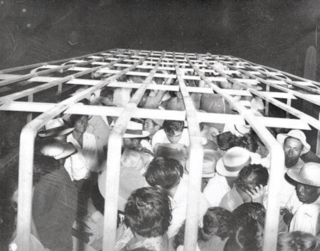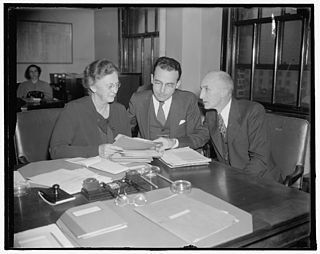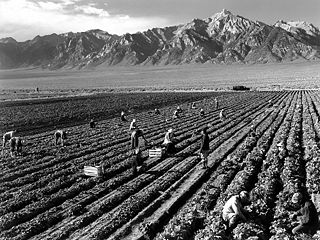Related Research Articles

The Cabinet of the United States is a body consisting of the vice president of the United States and the heads of the executive branch's departments in the federal government of the United States, which is regarded as the principal advisory body to the president of the United States. The president is not formally a member of the Cabinet. The heads of departments, appointed by the president and confirmed by the Senate, are members of the Cabinet, and acting department heads also sit at the Cabinet meetings whether or not they have been officially nominated for Senate confirmation. The president may designate heads of other agencies and non-Senate-confirmed members of the Executive Office of the President as members of the Cabinet.

The United States Department of Labor (DOL) is a cabinet-level department of the U.S. federal government, responsible for occupational safety and health, wage and hour standards, unemployment benefits, reemployment services, and occasionally, economic statistics. Many U.S. states also have such departments. The Department of Labor is headed by the U.S. Secretary of Labor.
The United States federal executive departments are the principal units of the executive branch of the federal government of the United States. They are analogous to ministries common in parliamentary or semi-presidential systems but they are led by a head of government who is also the head of state. The executive departments are the administrative arms of the President of the United States. There are currently 15 executive departments.
The term New Frontier was used by Democratic presidential candidate John F. Kennedy in his acceptance speech in the 1960 United States presidential election to the Democratic National Convention at the Los Angeles Memorial Coliseum as the Democratic slogan to inspire America to support him. The phrase developed into a label for his administration's domestic and foreign programs.
We stand today on the edge of a New Frontier—the frontier of the 1960s, the frontier of unknown opportunities and perils, the frontier of unfilled hopes and unfilled threats. ... The pioneers gave up their safety, their comfort, and sometimes their lives to build our new west. They were determined to make the new world strong and free - an example to the world. ... Some would say that those struggles are all over, that all the horizons have been explored, that all the battles have been won. That there is no longer an American frontier. ... And we stand today on the edge of a new frontier, the frontier of unknown opportunities and perils. ... Beyond that frontier are uncharted areas of science and space, unsolved problems of peace and war, unconquered problems of ignorance and prejudice, unanswered questions of poverty and surplus. ... I'm asking each of you to be pioneers towards that New Frontier. My call is to the young in heart, regardless of age. ... Can we carry through in an age where we will witness not only new breakthroughs in weapons of destruction, but also a race for mastery of the sky and the rain, the ocean and the tides, the far side of space, and the inside of men's minds? ... All mankind waits upon our decision. A whole world waits to see what we shall do. And we cannot fail that trust, and we cannot fail to try.

Operation Wetback was an immigration law enforcement initiative created by Joseph Swing, the Director of the United States Immigration and Naturalization Service (INS), in cooperation with the Mexican government. The program was implemented in June 1954 by U.S. Attorney General Herbert Brownell. The implementation of Operation Wetback was a result of Attorney General Henry Brownell's touring of Southern California in August 1953. It was here that he made note of the "shocking and unsettling" issue that was illegal immigration. The short-lived operation used military-style tactics to remove Mexican immigrants—some of them American citizens—from the United States. Though millions of Mexicans had legally entered the country through joint immigration programs in the first half of the 20th century, Operation Wetback was designed to send them back to Mexico.

Arthur Joseph Altmeyer was the United States Commissioner for Social Security from 1946 to 1953, and chairman of the Social Security Board from 1937 to 1946. He was a key figure in the design and implementation of the U.S. Social Security system.

James Paul Mitchell was an American politician and businessman from New Jersey. Nicknamed "the social conscience of the Republican Party," he served as United States Secretary of Labor from 1953 to 1961 during the Eisenhower Administration. Mitchell was a potential running mate for the 1960 Republican presidential candidate, Vice President Richard M. Nixon. However, Nixon chose Henry Cabot Lodge Jr. After an unsuccessful run for Governor of New Jersey in 1961, he retired from politics.
The Office of Education, at times known as the Department of Education and the Bureau of Education, was a small unit in the Federal Government of the United States within the U.S. Department of the Interior from 1867 to 1972.
Lewis Arthur Larson was an American lawyer, law professor, United States Under Secretary of Labor from 1954 to 1956, director of the United States Information Agency from 1956 to 1957, and executive assistant for speeches for U.S. President Dwight D. Eisenhower from 1957 to 1958.

The National Treasury Employees Union (NTEU) is an independent labor union representing 150,000 employees of 31 departments and agencies of the United States government. The union specializes in representation of non-supervisory federal employees in every classification and pay level in civilian agencies.
The Federal Security Agency (FSA) was an independent agency of the United States government established in 1939 pursuant to the Reorganization Act of 1939. For a time, the agency oversaw food and drug safety as well as education funding and the administration of public health programs and the Social Security old-age pension plan.
The steel strike of 1959 was a 116-day labor union strike by members of the United Steelworkers of America (USWA) that idled the steel industry throughout the United States. The strike occurred over management's demand that the union give up a contract clause which limited management's ability to change the number of workers assigned to a task or to introduce new work rules or machinery which would result in reduced hours or numbers of employees. The strike's effects persuaded President Dwight D. Eisenhower to invoke the back-to-work provisions of the Taft-Hartley Act. The union sued to have the Act declared unconstitutional, but the Supreme Court upheld the law.

A farmworker or agricultural worker is someone employed for labor in agriculture. In labor law, the term "farmworker" is sometimes used more narrowly, applying only to a hired worker involved in agricultural production, including harvesting, but not to a worker in other on-farm jobs, such as picking fruit.
Bertha Sheppard Adkins, was an educator, political activist, public servant, and a community leader.
Arthur Alden Kimball was an American civil servant and lawyer who was part of the prosecution staff for the Nuremberg Trials, and also helped establish the Economic Cooperation Administration for administering the Marshall Plan.
The U.S. President’s Advisory Committee on Government Organization was established by Executive Order 10432 on January 24, 1953. Members of the committee were appointed by President Dwight D. Eisenhower and served without compensation. Nelson A. Rockefeller served as Chairman until 1958; upon his resignation, Arthur S. Flemming served as Chairman. Other permanent members were Dr. Milton S. Eisenhower and Don K. Price, Jr. In addition to the permanent members, the committee had the services of experts from government, universities and business who acted as consultants. A few of the consultants were: Dr. Ernest Williams, Professor Emmette S. Redford, Herman Pollack, Fordyce Luikart, Willard Bascom, Jerold Kieffer, Joseph Dodge, and William Barclay Harding.

The Migrant and Seasonal Agricultural Worker Protection Act, codified at 29 U.S.C. §§ 1801-1872, is the main federal law that protects farm workers in the United States and repealed and replaced the Farm Labor Contractor Registration Act.
The presidency of Dwight D. Eisenhower began on January 20, 1953, when Dwight D. Eisenhower was inaugurated as the 34th president of the United States, and ended on January 20, 1961.
The Bureau of Labor Standards was an agency of the U.S. Department of Labor from 1922 until 1971. It was the direct predecessor of the Occupational Safety and Health Administration. The unit was formed as the Division of Labor Standards in November 1934, and renamed the Bureau of Labor Standards in 1948.

The presidential transition of John F. Kennedy began when John F. Kennedy won the 1960 United States presidential election, becoming the president-elect of the United States, and ended when Kennedy was inaugurated at noon EST on January 20, 1961.
References
- ↑ Government Printing Office. U.S. Government Organization Manual 1960-1961. Washington, DC: GPO. p. 556.